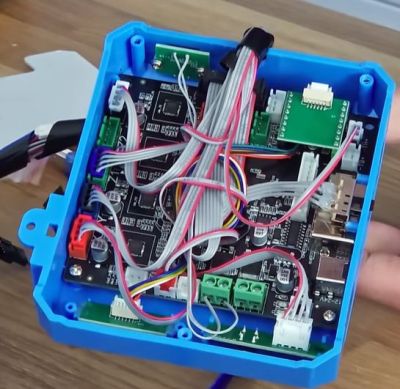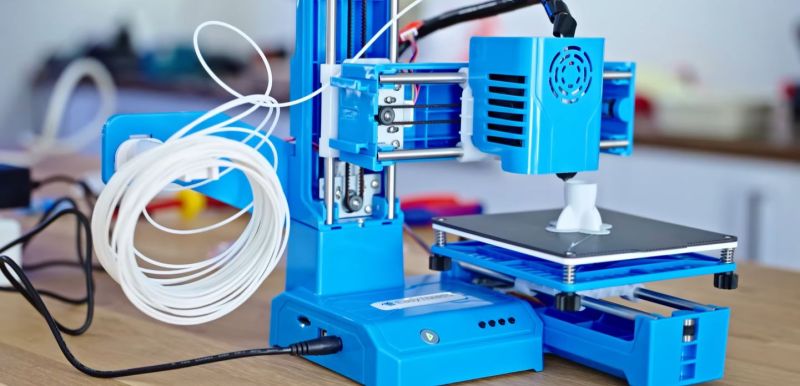![The hot end of the EasyThreed K9 is actually pretty nifty. (Credit: [Thomas Sanladerer])](https://hackaday.com/wp-content/uploads/2024/02/cheapest_fdm_printer_hotend.jpg?w=250)
What follows is both a mixture of wonder and horror, as the plastic build quality is everything but convincing, while at the same time, the self-contained nature of each of the three axes of the cantilevered design makes for very easy assembly. The print head has a nifty flip-up cover for easy access to the hot end, which makes the best of the anemic 24-watt power supply for the entire printer. A cooling fan with an air duct even provides part cooling, making this print head a contender for the ‘cheap but not terrible’ category. You can check out his full video review below.

[Thomas], of course, had to look at the control board. It turns out that it’s not a known controller, although some of the components are familiar, and many expansion options are visible on the PCB, including, potentially, WiFi.
The heart of the controller board is the ARERY AT32F403ARCT7 MCU, which [PeetHobby] in the comments notes is more or less an STM32 clone based on their experiences with the chip. This MCU runs at 240 MHz, with 1 MB flash and 256 kB SRAM, and a feature set and register layout similar to STM32 parts.
After running a few prints on the printer, [Thomas] concludes that although it’s not a terrible printer, the good parts about it are somewhat ruined by the slop in the connections between the axes. There’s also no easy way to use full filament spools with the printer, only the smaller 250-gram ones. Although a ‘no buy’ if you want to get an FDM printer that works out of the box, the amount of hacking potential here is rather large, as evidenced by the many comments about it.
We remember when a cheap printer was around $200. This isn’t the first Easythreed printer we’ve seen, but they do seem to be getting better.

















Looks like a Monoprice Select Mini (Malyan 200), stripped down to the minimum and built in plastic.
It actually works. It costs €72. And, more importantly, Thomas got clicks.
Who is Thomas?
The guy in the video thumbnail above this comments section.
It’s neat that €72 can buy something that’s roughly on par with early hobbyist printer kits that cost 10x this, but unless you’re doing so for your own enjoyment I wouldn’t consider this to have a lot of hacking potential. By the time you’ve substantially improved it you’ve probably added enough money and time into it to buy a slightly more expensive but vastly more capable machine. Modernized Ender 3 style printers can be had for less then €200 nowadays, which is pretty awesome.
Try to print a Prusa with it for free.
It’s an Artery CPU, they make some half decent STM clones (not sure if they’re licenced or not though), they seem to be used in a lot of Gotek ‘drives’ which are popular among the retro community.
It’s better than no 3d printer but it doesn’t seem good enough that it wouldn’t be worth spending a little extra cash for a lot better.
I was also thinking it might make the base of a low cost laser engraver but by the time you’ve added a diode with enough power to be useful then you’re in the price range of a better, low cost laser engraver.
So, more material and e-waste?
I got that printer. Its pretty nice for the price. The print quality is good, not perfect but for the most needs its fine.
Honestly a refurb ender 3 is very close in price and much more capable. The only thing with refurbs is they will likely need tuning up and possibly replacing some parts but imo that’s part of the fun of the hobby for me, tinkering!
Absolutely. At least with a refurb/repair you are probably getting some decent starting components. When everything is the cheapest version available, then ultimately everything needs upgraded, and you may as well have just built the thing from scratch… and ai have no problem with building from scratch, but save yourself the money and time of getting the wrong thing first in that case.
Also, any 3d printer user who is not a tinkerer is cruising for disappointment. Those types will print all the dumb funko-pop trinkets available on Thingiverse in about a month, then grow bored and the thing will collect dust/go out of calibration.
3d printing requires tinkering by nature of what it is. It’s not a magical box which creates consumer goods without any user craftsmanship, and arguably it shouldn’t be. We don’t need each household to be a mass plastics manufacturer, only the ones who are actually doing interesting things. Gatekeeping is good
CHEP comes to mind here. But the same cannot be said of Michael from Teaching Tech, Thomas Sanladerer from Made in Layers, or Stefan from CNCKitchen.
If the controller can be freely reprogrammed, then this might be a nice cheap 3 stepper motor driver + motors. Or an cheap XYZ platform for other projects.
An ender 3 pro silent mainboard is around 25USD/EUR less…
Too cheap (non-rigid) to be a general purpose xyz platform I’m guessing
got one for 50$ during sales as my first printer…
The defaults on it are pretty obvious, but it’s surprisingly capable for the price, a real steal imho…
I did invest in the heated bed option, changes all for first layer adhesion…
it’s also relatively trivial to use. save the gcode out of the slicer on the sd card. put the SD card in the printer, level the bed with the four easy button, press play and wait… if you make sure to correct backlash, the results are somehow useable…
Yeah. I think mine was $90 shipped on a Banggood deal or similar, an Anet A8 which is way bigger, more capable, basically better than this thing in every way. Cheap printing doesn’t seem to have advanced much in the last 8 years (also money is worth way less but we’re not supposed to acknowledge that yet)
I think I paid 150 EUR for my ANET A8 back in 2017. It has yet to burn down my house, and it miraculously can still print good enough for me to not have bothered with anything else.
For half the price, this seems like a pretty decent deal. Spool holder is a non-issue, the one that was delivered with the A8 was also atrocious and easily replaced. If you put a bit of effort into fixing the worst issues, and maybe get the heated bed version, this could be an acceptable emergency home printer.
It looks like a true minimum-viable/cost 3d printer. It also looks way more like a product than the Anet A8 build kit was. That was basically a box of parts with the bare minimum of custom parts for the shitty acrylic frame and plastic X-gantry ends, this actually has a bunch of custom parts designed for the minimum possible production costs at scale. Because of the parts-bin nature the Anet A8 probably has more parts with some re-use value, but this kit can be made far cheaper. Assembly also seems to be a breeze compared to the Anet A8.
Same here, I added thermal runaway protection pretty easily and mine was probably half that price. I think the A8 is clearly superior to this thing however
This vid really made me appreciate the $99 Ender 2 Pro I bought on a lark for my kid to use.
It is miraculous how much difference the 25¤ up to 100¤ does make to improve the quality and usability of 3d printers.
I really can’t stand these made-up brand names. Like, someone needs to go shake these people by the shoulders and scream at them “THREED IS NOT A WORD” until they finally get it. Amazon should really just drop the brand requirement so they can just be sold as nameless Chinese electronics.
Since when do names have to be words with meanings?
They don’t, but I get what he is saying. There is this odd trend where Amazon no-name Chinese brands get Romanized names which are basically randomly generated, like these: https://www.nytimes.com/2020/02/11/style/amazon-trademark-copyright.html
“Threed” is perhaps an exception, because it is at least pronounceable and I think that if it’s pronounced “three-dee” instead of rhyming with “tweed” it’s alright. Still hokey.
That’s a direct consequence of Amazon’s silly brand policy – to sell you need a unique brand name, and it must be a registered trademark. It’s just a pointless hurdle, and the easiest way to deal with it is to go to the US trademark office and put in a free application with some random gibberish for the trademark (just to ensure it doesn’t collide with an existing one.) There is absolutely no reason to put any effort into a proper brand identity.
Since I said so. Stop enabling this trash.
My first 3d printer was a Tronxy X1 that cost 150$ shipped. That thing turned out great prints, I made a lot of upgrades for it. Think that 150$ price was really good, you got actual steppers, actual rails, a normal extruder, a metal bed all the good stuff.